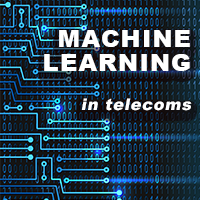Machine learning is fast becoming the catchphrase of the year, and with good reason; Google is using it to block spam, Morgan Stanley is using it to suggest trades, and hospitals are even using it to predict Sepsis. And machine leaning in the Telecoms industry is no exception, with CSPs investing in novel machine learning applications with the hope of reaping the benefits in the near future. In this blog we take a look at 5 machine learning applications that are beginning to emerge within the telecoms sector.
Machine Learning in the telecoms industry
By definition, machine learning is a type of artificial intelligence that allows digital devices to learn, without being explicitly programmed to. There are two primary branches of machine learning; supervised learning and unsupervised learning.
Supervised learning: A computer is provided example data with defined inputs and outputs, with the goal of learning a general rule that maps these inputs to the output options.
Unsupervised learning: A computer is provided data, but without any defined inputs and outputs to help learn a general rule. Instead, the computers goal is to discover hidden patterns independently.
The telecoms industry is uniquely prepared for machine learning, since network operators already have masses of data; they already collect and store customer data, network performance data, network traffic data, and social media data to name just a few sources. On top of this, they are also familiar with looking for patterns in data with applications such as network planning and root cause analysis. So it’s no surprise that a number of machine learning applications are already beginning to emerge within the telecoms sector.
1. Using machine learning to identify and restart sleeping cells
Just as your PC or laptop can unexpectedly crash, so can cell towers across the radio network. This can have a serious impact on service, especially within busy regions or busy times of the day. One machine learning application that is under development is to analyse and learn from network performance data to identify sleeping cells and trigger an automatic restart. Currently this is done manually, often leaving cell towers down for hours, if not days at a time, causing a negative impact on quality of service.
2. Using machine learning to identify potential churners
For network operators, customer churn is now a common occurrence as competition has heated up and new deals are continuously hitting the marketplace. Many operators already have simple pattern matching programmes in place to identify potential churners, however these are far from perfect, and require regular maintenance. Machine learning algorithms are being developed to continually learn from new data to understand why subscribers churn, and adapt as new patterns emerge.
3. Using machine learning to improve service uptake
The telecoms industry is no stranger to creating user profiles to enable targeted marketing of new services. However, there is a limit to the number of user profiles that can be identified, managed and kept up-to-date. To tackle this, unsupervised machine learning algorithms that are fed data on user behaviour across the network have the potential to identify new user profiles that have previously gone unnoticed, and continually develop these to match the subscriber with the most appropriate service package, in turn improving service uptake.
4. Using machine learning for fraud mitigation
Fraud and revenue assurance is a major issue within the telecoms industry, directly impacting the bottom line. Currently, most network operators utilise fraud mitigation tools which use rules based logic to identify fraudulent behaviour. However, supervised machine learning is now being used to develop algorithms that can automatically identify activity as fraudulent or non-fraudulent. Machine learning may also offer the potential to spot early trending anomalies associated with criminal behaviour.
5. Using machine learning to analyse social media
Social media has transformed from a way to keep in touch with friends and family, to a fully-fledged business communication channel. This has brought both new opportunities and new challenges to telecoms operators. With so many social posts to monitor, network operators have turned to machine learning to analyse brand coverage and customer sentiment. Real social posts are used to create an algorithm that can recognise language patterns and sentiment to identify trends and answer questions such as ‘what drives new customers to subscribe?’ and ‘When do subscribers seek out a competitor?’.

